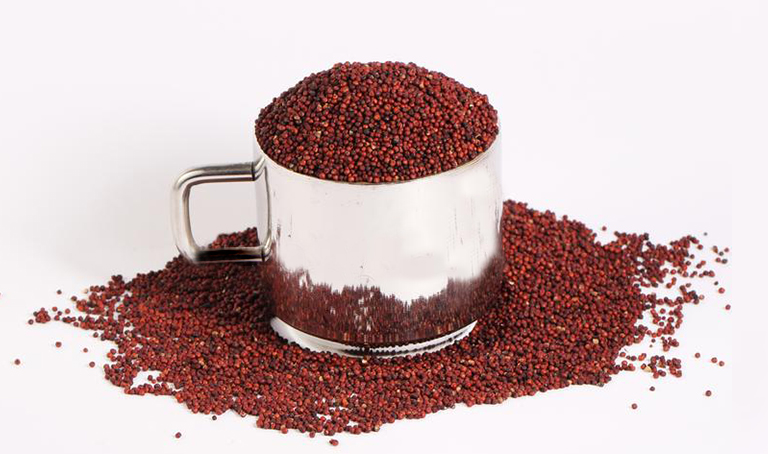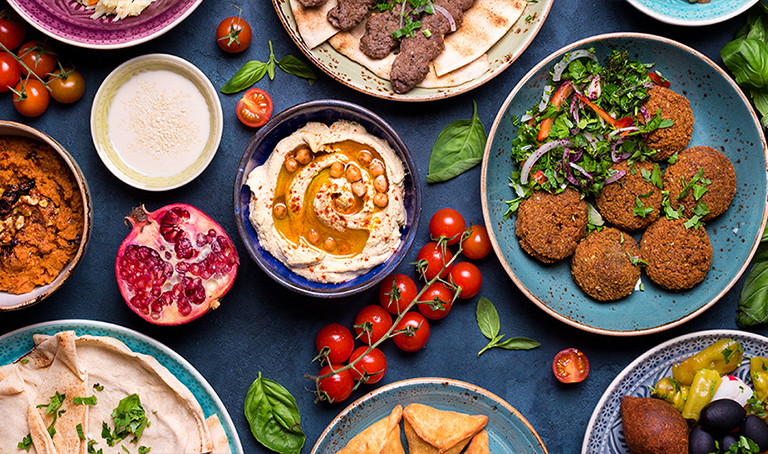INTRODUCTION
The term millet is derived from the French word “mille’’ which means thousand. A fistful of millet containing up to 1000 grains (Shahidi & Chandrasekara, 2013) and hence the name. Millets belong to the group of small-seeded species of cereal crops or grains which are annual plants (Shiihii et al., 2011). Finger millet, a member of the millet group and also known as Ragi or tamba or kezhvaragu (Jideani et al., 1996) is so called due to its growth which takes the form of finger like structures (Sood et al., 2017). The grain belongs to the family Poaceae which originated in Ethiopia and the sub-family Chloridodeae (Pradeep & Sreerama, 2015; Sood et al., 2016). Different cultivars of this grain with different grain color is cultivated such as brown, light brown and white. The white cultivars have been developed mainly for the baking industry, the brown and light brown types used for porridge while the brown cultivar is utilized for brewing traditional opaque beer in Southern Africa (Sood et al., 2017).
CULTIVATION
The grain is a semi-arid region crop cultivated in dry areas with limited rainfall and can adapt to various agro-climatic conditions (Gull et al., 2014).Ragi is cultivated in Asian countries such as Nepal, Sri Lanka, Bhutan and India. Cultivation in the orient is evident in Taiwan, China, Japan (to a limited extent), as well as in South Carolina in the United States .About 55-60% of globally produced Ragi is from Africa (Dlamini & Siwela, 2015), mainly in Ethiopia, Kenya, Nigeria, Malawi, Tanzania, Uganda, Zambia and Zimbabwe ,followed by India. Ragi is the oldest cultivated cereal crop in India and is referred to as “nrttakondaka”, although also named “rajika’’ or “markataka” which means dancing grain
NUTRIENT COMPOSITION
Ragi is gluten-free, non-acid-forming (Muthamilarasan et al., 2016) and easy to digest low glycemic index food (Manjula & Visvanathan, 2014).
Its low glycemic index (54-68) makes it a good substitute for rice when consumed as whole grains /flour without much processing. Diabetics and people with celiac disease can opt for this wonder grain in place of rice or wheat. Ragi is nutritionally dense and comprises rich concentrations of dietary fiber, carbohydrates, iron and calcium when compared to other cereal grains (Sood et al., 2016).
High amounts of magnesium and phosphorus is also evident. Absorption and utilization of these nutrients in the human body contributes to the reduction of chronic diseases/disorders such as high blood pressure, ischemic stroke, cardiovascular diseases, cancer, obesity and type II diabetes (Kaur et al., 2014).
Ragi contains essential minerals such as calcium and phosphorus. The grains contain the highest amount of Calcium, ranging from 162.0-358.0 mg/100 g when compared to other millet species (Roopa & Premavalli, 2008; Manjula et al., 2015).
The concentration of Phosphorous in Ragi ranges from 130.0-283.0 mg/g. Other minerals present include iron with a concentration of 3-20% (Rajiv et al., 2011; Shukla & Srivastava, 2014) and magnesium. This is of particular importance to several mothers and their children who need the extra calcium but cannot afford milk or other sources of this mineral .
Ragi has good amounts of Vitamin A and B vitamins as can be evidenced through various research studies on its composition (Table 1). Ragi contains 44.7% of essential amino acids and essential fatty acids such as linolenic and palmitic acids which are essential for the development of brain and neural tissue (Kunyanga et al., 2013; Muthamilarasan et al., 2016).The Ragi protein contains an amino acid that is missing in Rice-Methionine. This is one of the essential amino acids that is critical for hair,skin ,nails and healthy liver
HEALTH BENEFITS OF RAGI
DIETARY FIBER AND ITS ROLE IN HUMAN HEALTH
The dietary fiber in Ragi play a key role in controlling and regulating the release of blood sugar .This means that this grain is valuable both in prevention and management of Diabetes Mellitus .Dietary fiber also plays an important role in prevention of cardio-vascular diseases. The World Health Organization defines overweight and obesity as abnormal or excessive fat accumulation that may impair health. The most common health consequence of being overweight or obese is cardiovascular disease — mainly heart disease and stroke. The more overweight a person is the more likely he/she is to develop heart disease. Increased weight is a determinant of higher levels of triglycerides, elevated LDL (commonly known as bad cholesterol) and low HDL (commonly known as good cholesterol). However, even a slight reduction in weight (5- 10 per cent) can reduce a person’s risk of heart disease. Dietary fibre in whole grains acts as a sponge, absorbing water and thus increasing the “bulk’ of the food . It promotes satiety and as a result one tends to eat less, resulting in weight loss.
Low fat content of Ragi together with its dietary fiber and higher amounts of carbohydrates which are available in the form of non-starchy polysaccharides makes this grain nutritionally dense and important for its hypocholestrolemic and hypoglycemic effects (Vanithasri et al., 2012; Banusha & Vasantharuba, 2013).
Constipation is a condition that is generally aggravated by a sedentary life style, lack of exercise and deprivation of fiber rich diet. Chronic fiber deprivation can lead to intestinal diseases such as hemorrhoids and irritable bowel syndrome. The link between colon and rectal cancer and low consumption of fiber is the focus of researchers today.
Thus a few Ragi rotis, a Ragi mudde or a bowl of Ragi porridge will not only fuel a person with enough energy but also take care of digestion, heart, arteries and blood sugar.
ROLE IN PREVENTING MALNUTRITION
The grain’s protein content is comparable to that of rice. However, some Ragi varieties have shown double that level.
More importantly, this protein content is quite unique. The main protein fraction is eleusinin, which has a high biological value, meaning that it is easily incorporated into the body. There are also significant quantities of tryptophan, cystine, methionine and total aromatic amino acids, all crucial to human health. This high protein content makes Ragi a very important factor in preventing malnutrition. This millet can be an especially good source of protein for vegetarians because of its methionine content that constitutes about 5% of the protein.
ROLE IN DIABETES MELLITUS MANAGEMENT
The rapid rise in the prevalence of diabetes has led to a great demand for foods containing complex carbohydrates with high dietary fiber levels and beneficial phytochemicals.
Phytochemicals are a varied group of chemical compounds derived from plants, which are considered to be important factors in our capacity to combat disease. All these components are usually found in the outer layer of the grain or the seed coat, and so, it is generally a good idea to consume whole grains.
The Ragi grain’s seed coat is rich in polyphenols as compared to grains such as barley, rice, maize and wheat. It has 40 times the phenolic content of rice and 5 times that of wheat. Among the millets, it is comparable to foxtail millet, and second only to kodo millet. Research studies have also shown that Ragi controls blood glucose levels, and hyperglycemic and oxidative stress. It has also shown promise in accelerating wound healing among diabetics.
ANTI MICROBIAL PROPERTIES
Ragi has been found to act against a number of bacteria including Bacillus cereus, which causes food poisoning, Salmonella sp., which causes a typhoid-like fever, and Staphylococcus aureus, one of the primary causes of skin and soft tissue infections such as abscesses, furuncles, and cellulitis.
ROLE AS AN ANTIOXIDANT
Ragi is also rich in antioxidants, which are compounds that prevent excessive oxidation. The phenolic acids, flavonoids and tannins present in finger millet seed coats have very effective antioxidant properties thus protecting our body against cell damage which could cause ageing and cancer. Research evidences indicate that , people on millet-based diets have lower incidences of esophageal cancer than those on wheat or rice diets.
Thus this extremely nutritious millet is a valuable food source of several nutrients essential to the human body. A super grain that made a comeback in recent years, Ragi can be a valuable part of our diets in a variety of food forms ranging from a simple porridge to a chocolate cake.
REFERENCES
- Dlamini, N. R., & Siwela, M. (2015). The future of grain science: the contribution of indigenous small grains to food security, nutrition, and health in South Africa. Cereal Foods World, 60(4), 177-180
- Gull, A., Jan, R., Nayik, G. A., Prasad, K., & Kumar, P. (2014). Significance of finger millet in nutrition, health and value added products: a review. Journal of Environmental Science, Computer Science and Engineering and Technology, 3(3), 1601-1608
- Jideani, I. A., & Jideani, V. A. (2011). Developments on the cereal grains Digitaria exilis (acha) and Digitaria iburua (iburu). Journal of Food Science and Technology, 48(3), 251-259.
- Kaur, K. D., Jha, A., Sabikhi, L., & Singh, A. K. (2014). Significance of coarse cereals in health and nutrition: A review. Journal of Food Science and Technology, 51(8), 1429-1441
- Kunyanga, C. N., Imungi, J. K., & Vellingiri, V. (2013). Nutritional evaluation of indigenous foods with potential food-based solution to alleviate hunger and malnutrition in Kenya. Journal of Applied Biosciences, 67(0), 5277-5288
- Muthamilarasan, M., Dhaka, A., Yadav, R., & Prasad, M. (2016). Exploration of millet models for developing nutrients rich graminaceous crops. Plant Science, 242, 89-97
- Manjula, B., & Visvanathan, R. (2014). Process optimisation of extruded breakfast cereal from rice mill brokens-finger millet-maize flour blends. International Journal of Food and Nutritional Sciences, 3(4), 66-71.
- Pradeep, P. M., & Sreerama, Y. N. (2015). Impact of processing on the phenolic profiles of small millets: Evaluation of their antioxidant and enzyme inhibitory properties associated with hyperglycemia. Food Chemistry, 9, 455-463.
- Rajiv, J., Soumya, C., Indrani, D., & Venkateswara Rao, G. (2011). Effect of replacement of wheat flour with finger millet flour (Eleusine coracana) on the batter microscopy, rheology and quality characteristics of muffins. Journal of Texture Studies, 42(6), 478-489
- Roopa, S., & Premavalli, K. S. (2008). Effect of processing on starch fractions in different varieties of finger millet. Food Chemistry, 106(3), 875-882
- Shahidi, F., & Chandrasekara, A. (2013). Millet grain phenolics and their role in diseases risk reduction and health promotion – review. Journal of Functional Foods, 5(2), 570-581.
- Shiihii, S. U., Musa, H., Bhati, P. G., & Martins, E. (2011). Evaluation of physicochemical properties of Eleusine coracana starch. Nigerian Journal of Pharmaceutical Sciences, 10(1), 91-102.
- Shukla, K., & Srivastava, S. (2014). Evaluation of finger millet incorporated noodles for nutritive value and glycemic index. Journal of Food Science and Technology, 51(3), 527-534. http
- Sood, S., Kant, L., & Pattnayak, A. (2017). Finger millet [Eleusine coracana (L.) Gaertn.]: a minor crop for sustainable food and nutrition. Mini Review. Asian Journal of Chemistry, 29(4), 707-710.


